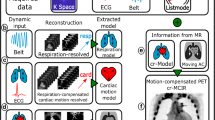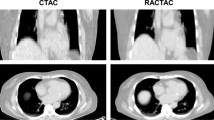Abstract
Background
Coronary PET shows promise in the detection of high-risk atherosclerosis, but there remains a need to optimize imaging and reconstruction techniques. We investigated the impact of reconstruction parameters and cardiac motion-correction in 18F Sodium Fluoride (18F-NaF) PET.
Methods
Twenty-two patients underwent 18F-NaF PET within 22 days of an acute coronary syndrome. Optimal reconstruction parameters were determined in a subgroup of six patients. Motion-correction was performed on ECG-gated data of all patients with optimal reconstruction. Tracer uptake was quantified in culprit and reference lesions by computing signal-to-noise ratio (SNR) in diastolic, summed, and motion-corrected images.
Results
Reconstruction using 24 subsets, 4 iterations, point-spread-function modelling, time of flight, and 5-mm post-filtering provided the highest median SNR (31.5) compared to 4 iterations 0-mm (22.5), 8 iterations 0-mm (21.1), and 8 iterations 5-mm (25.6; all P < .05). Motion-correction improved SNR of culprit lesions (n = 33) (24.5[19.9-31.5]) compared to diastolic (15.7[12.4-18.1]; P < .001) and summed data (22.1[18.9-29.2]; P < .001). Motion-correction increased the SNR difference between culprit and reference lesions (10.9[6.3-12.6]) compared to diastolic (6.2[3.6-10.3]; P = .001) and summed data (7.1 [4.8-11.6]; P = .001).
Conclusions
The number of iterations and extent of post-filtering has marked effects on coronary 18F-NaF PET quantification. Cardiac motion-correction improves discrimination between culprit and reference lesions.







Similar content being viewed by others
Abbreviations
- PET:
-
Positron emission tomography
- CT:
-
Computed tomography
- ACS:
-
Acute coronary syndrome
- CTA:
-
Computed tomography angiography
- ECG:
-
Electrocardiograph
- SNR:
-
Signal-to-noise ratio
- TBR:
-
Tissue-to-background ratio
- SUV:
-
Standardized uptake value
References
Joshi NV, Vesey AT, Williams MC, Shah AS, Calvert PA, Craighead FH, et al. 18F-fluoride positron emission tomography for identification of ruptured and high-risk coronary atherosclerotic plaques: A prospective clinical trial. The Lancet 2014;383(9918):705-13.
Lee JM, Bang JI, Koo BK, Hwang D, Park J, Zhang J, et al. Clinical relevance of 18F-sodium fluoride positron-emission tomography in noninvasive identification of high-risk plaque in patients with coronary artery disease. Circ Cardiovasc Imaging 2017;10(11):e006704.
Kitagawa T, Yamamoto H, Toshimitsu S, Sasaki K, Senoo A, Kubo Y, et al. Data on analysis of coronary atherosclerosis on computed tomography and 18F-sodium fluoride positron emission tomography. Data Brief 2017;13:341-5. https://doi.org/10.1016/j.dib.2017.06.011.
Kitagawa T, Yamamoto H, Toshimitsu S, Sasaki K, Senoo A, Hirokawa Y, et al. 18F-sodium fluoride positron emission tomography for molecular imaging of coronary atherosclerosis based on computed tomography analysis. Atherosclerosis 2017;263:385-92.
Rubeaux M, Joshi N, Dweck M, Fletcher A, Motwani M, Germano G, et al. Motion-correction of 18F-sodium fluoride PET for imaging coronary atherosclerotic plaques. J Nucl Med 2016;57(1):54–9.
Vercauteren T, Pennec X, Perchant A, Ayache N. Symmetric log-domain diffeomorphic registration: A demons-based approach. Med Image Comput Comput Assist Interv 2008;11:754-61.
Rubeaux M, Joshi N, Dweck MR, Fletcher A, Motwani M, Thomson LE, et al. Demons vs Level-Set motion registration for coronary (18)F-sodium fluoride PET. In: Styner MA, Angelini ED, editors. Proc SPIE Int Soc Opt Eng 2016;9784:97843Y-1.
Dru F, Vercauteren T. An ITK implementation of the symmetric log-domain diffeomorphic demons algorithm. 2017;1-11.
Thie JA. Understanding the standardized uptake value, its methods, and implications for usage. J Nucl Med 2004;45(9):1431-4.
Boellaard R, Krak NC, Hoekstra OS, Lammertsma AA. Effects of noise, image resolution, and ROI definition on the accuracy of standard uptake values: A simulation study. J Nucl Med 2004;45(9):1519-27.
Tawakol A, Migrino RQ, Bashian GG, Bedri S, Vermylen D, Cury RC, et al. In vivo 18F-fluorodeoxyglucose positron emission tomography imaging provides a noninvasive measure of carotid plaque inflammation in patients. J Am Coll Cardiol 2006;48(9):1818-24.
Rudd JH, Myers KS, Bansilal S, Machac J, Rafique A, Farkouh M, et al. (18)Fluorodeoxyglucose positron emission tomography imaging of atherosclerotic plaque inflammation is highly reproducible: Implications for atherosclerosis therapy trials. J Am Coll Cardiol 2007;50(9):892-6.
Asabella AN, Ciccone MM, Cortese F, Scicchitano P, Gesualdo M, Zito A, et al. Higher reliability of 18F-FDG target background ratio compared to standardized uptake value in vulnerable carotid plaque detection: A pilot study. Ann Nucl Med 2014;28(6):571-9.
Rudd JH, Myers KS, Bansilal S, Machac J, Pinto CA, Tong C, et al. Atherosclerosis inflammation imaging with 18F-FDG PET: Carotid, iliac, and femoral uptake reproducibility, quantification methods, and recommendations. J Nucl Med 2008;49(6):871-8.
Vesey AT, Jenkins WS, Irkle A, Moss A, Sng G, Forsythe RO, et al. 18F-fluoride and 18F-fluorodeoxyglucose positron emission tomography after transient ischemic attack or minor ischemic stroke: Case–control study. Circ Cardiovasc Imaging 2017;10(3):e004976.
Huet P, Burg S, Le Guludec D, Hyafil F, Buvat I. Variability and uncertainty of 18F-FDG PET imaging protocols for assessing inflammation in atherosclerosis: Suggestions for improvement. J Nucl Med 2015;56(4):552-9.
Shechter G, Resar JR, McVeigh ER. Displacement and velocity of the coronary arteries: Cardiac and respiratory motion. IEEE Trans Med Imaging 2006;25(3):369-75.
Soret M, Bacharach SL, Buvat I. Partial-volume effect in PET tumor imaging. J Nucl Med 2007;48(6):932-45.
Akamatsu G, Ishikawa K, Mitsumoto K, Taniguchi T, Ohya N, Baba S, et al. Improvement in PET/CT image quality with a combination of point-spread function and time-of-flight in relation to reconstruction parameters. J Nucl Med 2012;53(11):1716-22.
Schaefferkoetter J, Casey M, Townsend D, Fakhri El G. Clinical impact of time-of-flight and point response modeling in PET reconstructions: A lesion detection study. Phys Med Biol 2013;58(5):1465-78.
Disclosure
No other potential conflict of interest relevant to this article was reported.
Author information
Authors and Affiliations
Corresponding author
Additional information
Funding This research was supported in part by grant 1R01HL135557 from the National Heart, Lung, and Blood Institute/National Institute of Health (NHLBI/NIH). The content is solely the responsibility of the authors and does not necessarily represent the official views of the National Institutes of Health. The study was also supported by a grant (“Cardiac Imaging Research Initiative”) from the Adelson Medical Research Foundation. David Newby (CH/09/002), Marc Dweck (FS/14/78), and Mhairi Doris (FS/17/79/33226) are supported by the British Heart Foundation. David Newby is also the recipient of a Wellcome Trust Senior Investigator Award (WT103782AIA).
Rights and permissions
About this article
Cite this article
Doris, M.K., Otaki, Y., Krishnan, S.K. et al. Optimization of reconstruction and quantification of motion-corrected coronary PET-CT. J. Nucl. Cardiol. 27, 494–504 (2020). https://doi.org/10.1007/s12350-018-1317-5
Received:
Accepted:
Published:
Issue Date:
DOI: https://doi.org/10.1007/s12350-018-1317-5




